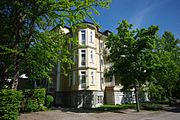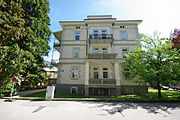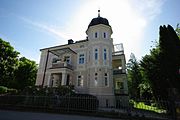Ensemble spa district

The ensemble spa district is a group of buildings in Bad Reichenhall and is in accordance with Article 1, paragraph 3 of the Bavarian Monument Protection Act under monument protection . The ensemble includes the so-called spa district , which lies between Salzburger Strasse and between the cross axes of Rinckstrasse and Mozartstrasse. The development with spa pensions, bathing hotels and richly designed pension villas dates back to the Wilhelminian era and the turn of the century and thus from the heyday of Reichenhall as a royal Bavarian state spa.
description
The ensemble covers the area between Mack-, Rinck-, Ottilien-, Mozart- and Salzburger Straße. This area is called the spa district because of the development with spa guest houses, bathing hotels and pension villas from the Wilhelminian era and the turn of the century . The buildings are surrounded by house gardens and structurally structured by risalits , bay windows and verandas ; at the crossroads, tower-like corner formations and bay windows set urban accents. In addition to some Art Nouveau details, there are predominantly Neo-Renaissance and Neo- Baroque forms . The concept and development of Mackstraße embodies a particularly characteristic street from around 1900 and, with its tree planting, has the character of a promenade . The building at Mozartstrasse 3, built in 1993 according to the original plan from the 19th century, forms the end of the ensemble. The new building at Rinckstrasse 8 was built earlier, does not fit into the elegant historical concept and is a disturbance in the ensemble.
history
During the heyday of Bad Reichenhall as a spa and bathing resort, the spa district was built in the spa district towards the end of the 19th century and at the turn of the century in the immediate vicinity of the spa house and the spa garden on the border with the then independent municipality of St. Zeno , where large parts of the elaborate architectural style of that time has been preserved.
The namesake of Mackstrasse and Rinckstrasse in particular have a very close relationship to the spa in Bad Reichenhall and thus also to the spa district. Mathias Mack was a pharmacist in Bad Reichenhall, mayor and pioneer of mountain pine oil distillation . Ernst Rinck opened the first brine and whey spa facility in the city in the Axelmannstein at the same time that Mack took over his pharmacy on what is now the corner of Max-Zugschwerdt-Strasse and Ludwigstrasse . In their functions as pharmacists, business people, hoteliers and mayors, they set the course for the city's success as a health resort.
Individual monuments
Mackstrasse
- Mackstraße 4: Villa Palmina, three-storey hipped roof building with corner oriel tower , gable , cast-iron balconies and neo-renaissance plaster structure, around 1900
- Mackstraße 7: Kurpension, large four-storey complex with mezzanine , above it a strong eaves cornice and roof balustrades, with multi-storey balconies and plastered structures, in historicizing design, by Jakob Dürk, 1905
Mozartstrasse
- Mozartstraße 5: Villa, representative two-storey mansard roof building with split gable projections and corner bay tower, in neo-baroque design , based on plans by Josef Adlmannseder, inscribed. 1903; Associated guest or servant house, eaves side building with side gable projections, original unplastered slag masonry, decorative framework on the upper floor and wooden gallery, at the same time
- Mozartstrasse 10: Former Kurpension, two-storey, representative corner building with mansard roof, volute gable risalits , corner bay tower with onion helmet and baroque plaster decor, based on plans by Martin Rott, 1904
Ottilienstraße
- Ottilienstraße 1: Villa, former summer house, two-storey hipped roof building over high basement and mezzanine with risalits, corner loggias and plaster structures, in historicizing design, 1905/06; Remise , wooden paneled pent roof building on one floor , at the same time; Street-side fence , at the same time
Rinckstrasse
- Rinckstraße 6: Villa, two-storey corner building above a high basement with a mezzanine and flat hipped roof, loggias and wrought-iron balconies, risalites with baluster parapets , late Classicist style , late 19th century
- Rinckstraße 11: Kurpension Villa Toskana, three-storey building above a high basement floor with mezzanine, flat hipped roof, risalits with attic , neo-Renaissance plastered structures and cast-iron balconies, around 1900
- Rinckstraße 12: Villa, former Kurpension Villa Morgenroth, three-storey corner building with a flat hipped roof, risalits, corner bay tower and cast-iron and recessed balconies, end of the 19th century, gutted inside
Salzburger Strasse
- Salzburger Straße 17: doctor's villa, two-storey hipped roof building with central projection and triangular gable , reduced neo-baroque , by Franz Zell, 1913; associated enclosure, at the same time
- Salzburger Straße 18: Kurpension Villa Vakuna, two-storey asymmetrical neo-renaissance building with mezzanine and corner bay tower, tail gable and multi-storey balconies, re. 1902
- Salzburger Straße 20: Villa Hortensia, picturesque two-storey neo-renaissance building with mezzanine, tail gable, corner bay tower and balconies, 1902; wrought iron enclosure, at the same time
See also
literature
- List of monuments of the Bavarian State Office for Monument Preservation
- Johannes Lang : History of Bad Reichenhall. Ph.CW Schmidt, Neustadt / Aisch 2009, ISBN 978-3-87707-759-7 .
- Herbert Pfisterer: Bad Reichenhall in its Bavarian history Motor + Touristik-Verlag, Munich, 1988
Web links
- Bavarian Monument Atlas (cartographic representation of the Bavarian architectural and ground monuments by the BLfD , requires JavaScript)
Coordinates: 47 ° 43 ′ 45.2 ″ N , 12 ° 53 ′ 1 ″ E










